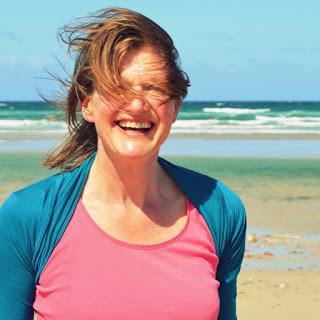
Bond of Union by M.C. Escher*
When I read the Yoga for Healthy Aging post Requesting Reader Feedback, I suffered the usual dilemma: do I say too much or nothing? So I stalled. I’m a part-time, wayward kind of yogi who believes, because it suits me, that the road to enlightenment can be any old path you choose as long as you keep the light in mind. I’ve loved so much of the down-to-earth, practical, wide-ranging and indeed wise advice from YFHA. That meant I found it hard to pick out one article that summarises all I’ve gained from the forum. There was one area, however, that I felt was almost entirely missing: the relationship between yoga and ecological activism.Yoga as a practice is about uniting the different aspects of ourselves: our minds, our bodies, our thoughts and emotions. The practice develops our understanding of why we do what we do, the attitude we have to all our relationships, what we’re responsible for. In the Brihadaranyakaya Upanishad (trans. Max Muller, 1879), Ganaka Vaideha asks, “Who is the Self?” Yâgñavalkya replies: “He who is within the heart, surrounded by the Prânas (senses), the person of light, consisting of knowledge”.
This “being within the heart” involves understanding what one is united with, or yoked to (the derivation most commonly ascribed to the word “yoga”). “Surrounded by the senses” also means being aware of what the senses bring in to us and how. We are porous creatures. We interact with the world around us at a molecular level, breathing in, breathing out.
So when we breathe in, what we breathe in is air but the air is full of human attitudes. When we become aware of them, we cannot un-see the attitudes of factory owners in countries, however far away, who make yoga mats and clothes, and all the technological innovations that simplify, speed up, or otherwise make our lives easier. We realize that the pollution that is pumped into the rivers, legally or illegally, the waste that’s dumped on land or at sea, the huge urban sprawls created by the manufacturing sectors in countries where people have few choices about what work to take—all these are inseparable from us. We are that. We cannot unsee agricultural practices that feed us cheap food by creating deforestation, desertification, chemical pollution, climate change, extinction of species, loss of habitat, fragmentation. We become aware of the unbroken thread between a booming stock market and loss of livelihood in drought-husked Kenya, refugee crises in Syria, tar sands, pipelines, plundering the newly opened North West passage to access oil. We become aware that we are that. That this is happening now, on our watch, under our gaze, as we meditate or stretch.
What can we do? It can feel overwhelming. That is the challenge that Arjuna faced in the Gita: How can we hope to succeed in action when the outcome is so uncertain? This challenge confronts us every day, but practicing an attitude of non-attachment to the outcome, as Krishna recommends Arjuna, helps us detach from panic.
Compassion, for ourselves, and for the web we’re woven into, is also vital if we are to have the energy to act. And compassion, or karuna, is a rock of yoga, firm and grounding. We can generate karuna for ourselves, for all the systems that sustain and create flourishing in our lives, and we can then stretch beyond even that, into the realm of loving enemies. Love is the most foundational attitude we can have. If we understand what is going on with an attitude of love, we will find answers everywhere.
Kripa is mercy in yogic terms. We cannot learn if we cannot forgive ourselves and others for the mess we are in. Acceptance and forgiveness are essential to our flexibility,. Our ability to respond and to trust in the tremendous resilience of natural systems and to believe that we cannot know the outcome but can only engage in the process, depends on kripa
Practicing yoga then gives us the strength and resilience to act. To practice means both to get better at, and to do something as part of a way of life. When we practice yoga, we confirm we are at home in the universe. We are at one with all the systems and processes that are unfolding in and around us, because they are what we are. This is union.
With practice, there is nothing we can’t handle. With practice, we open to what nature teaches us: reciprocity, energy flow, symbiosis. With practice we connect to all else. The practice of yoga, which we usually think of as the physical space on the mat and in our bodies, is actually about our relationship with ourselves, other humans, and all the systems that create and sustain our survival. As soon as we realize this, we are engaged in ecological activism.
Then our practice motivates us to do all the small things, the local things: buy less stuff in general, buy more stuff from local, ethical producers. Challenge food waste in supermarkets—collect the food and redistribute it. Reuse things (bottles and jars make good alternative lunch boxes), recycle what you can’t reuse (not just plastics, but also clothes, books, CDs). Set up local exchange systems with friends or by creating communities, networks, and support groups. Reach out. Learn the basic principles of living in harmony: positive interactions, doing what needs to be done, not just what your role denotes, criticising that act, not the individual. Be kind, because we are—humankind. Plant gardens (and waysides) with bee-friendly flowers, lobby the local council to allow your group to plant free food in wastelands, vegetables and herbs that anyone can pick. Lobby to have glyphosphates banned in your area. Organise local clean ups of rivers and woodlands, and recycle the resulting plastics wherever possible.
Finally, practice gets us into the big stuff. Petition universities to divest their investment funds from Big Oil, challenge governments on climate change actions that inherently contradict other policies, ask why governments subsidise oil companies and why oil companies fund research that questions the reality of climate change. Ask who is polluting rivers in our areas and who is paying for the clean up. Ask about fracking: who is funding it, whose lives are affected, what is it doing to natural systems? Find out if someone is working on it, and if not, ask for help from outside the area.
Get to know who your local and national politicians are, and let them get to know you. Write to them. Short is good. Green websites and lobby groups often have set letters that will help, though it’s even better, of course, if we can make it unique. This is our chance to express what we have to say. If we don’t feel we know enough, we can make friends with someone who does!
The practice of yoga is fundamentally the practice of living in harmony with all the systems that create and sustain us. We discover peace, shanti, through healing our relationship with others and with the world. We do this by taking on as much as we can without overstretching. We cannot do everything. Just as in our practice on the mat, we need to find a line between effort and surrender, so in ecological practice we find:
“The small, old path stretching far away [that] has been found by me...on which sages who know Brahman move on to the Svarga-loka (heaven), and thence higher on, as entirely free”
Each act creates ripples. Karuna, kripa, and shanti—love, forgiveness, and peace—are already the seeds of ecological activism.
Acknowledgment: I would like to thank Raymond Clyde Cooper who has been inspirational in my life, who has restored a river system in the west of Ireland, and who provided the following references:
Encyclopedia of Religion and Nature
Yoga Ecology Transforming the Inner and Outer Environments
The Vedic View of Ecology
The Anticipatory Community and The Yoga of Ecology The Yoga of Ecology: The Garden of Seven Gates
Yoga and Ecology

Subscribe to Yoga for Healthy Aging by Email ° Follow Yoga for Healthy Aging on Facebook ° Join this site with Google Friend Connect

